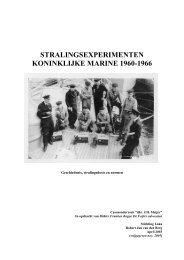CHERNOBYL; CHRONOLOGY OF A DISASTER - Antenna
CHERNOBYL; CHRONOLOGY OF A DISASTER - Antenna
CHERNOBYL; CHRONOLOGY OF A DISASTER - Antenna
You also want an ePaper? Increase the reach of your titles
YUMPU automatically turns print PDFs into web optimized ePapers that Google loves.
Italy, Sweden, Finland, Lithuania and Poland) the levels of<br />
Caesium-137 still vastly exceed normal levels. In the regions<br />
worst hit by the fall-out from Chernobyl, contamination levels<br />
will remain high and relatively unchanged for the next decades,<br />
the EC believes.<br />
Shelter Implementation Plan<br />
In 2005, the SIP (Shelter Implementation Plan) entered<br />
its final stage. All major Chernobyl site infrastructure facilities<br />
and programs (radiation and industrial protection,<br />
medical training, emergency response) have either been<br />
completed or will be at final acceptance over the next<br />
few months. These facilities and programs will, according<br />
to the EBRD “ensure adequate protection of people<br />
during the construction activities”, which have commenced<br />
and which will significantly increase during the year.<br />
Site services in the construction zone have been renewed<br />
and a change facility constructed. The physical work on<br />
stabilisation of the existing shelter is ongoing under the<br />
contract signed in July 2004. When completed in 2006,<br />
it will eliminate one of the principal risks - the collapse of<br />
the shelter. A comprehensive monitoring system (nuclear,<br />
radiation and seismic) as well as the site access control<br />
and physical protection system are under construction<br />
and scheduled for completion during the first half of<br />
2006.<br />
The tenders for the new safe confinement - the largest<br />
component of the SIP - are at an advanced stage of<br />
evaluation with contract award scheduled for Autumn<br />
2005. The confinement is an enormous arch - with a span<br />
of 260 meters and height of 100 meters - to enclose the<br />
existing ‘sarcophagus’ and its radioactive contents for a<br />
period of minimum 100 years. It is being constructed off<br />
site to limit workers’ exposure to radiation. The archshaped<br />
confinement will be erected and slid into position<br />
over the old shelter via specially built rails. Once in place,<br />
safer working conditions will enable the deconstruction of<br />
unstable parts of the shelter.<br />
12 May: At a pledging meeting in London the European<br />
Commission announced an additional €49 million to the<br />
international Chernobyl Shelter Fund (CSF). A total of about<br />
US$200 million are donated at the donor meeting. The project<br />
is estimated to cost US$1,091 million and is planned to be<br />
completed by 2009.<br />
4 August: Alpha-radiation from plutonium-241 decay products<br />
is increasing. Pu-241 emits Beta-radiation and has a<br />
half-life of only 14.4 years. It decays in Americium-241which<br />
emits alpha-radiation and has a half life 432.2 years. Result:<br />
in Belarus alpha-radiation is currently three-times as high as<br />
in 1986 and in the year 2276 the level will still be twice as high<br />
as shortly after the 1986 disaster. The zone’s americium-241<br />
will reach its maximum level in 2059. Am-241’s alpha radiation<br />
is even more powerful than plutonium’s, and it decays<br />
to neptunium-237, which also decays by way of an energetic<br />
alpha particle and has a half-life of more than 2 million years.<br />
However, the vast majority of radiation exposure is from betaemitting<br />
caesium-137 which is declining with a half-life of<br />
about 30 years.<br />
5 August: As a result of amnesties, Professor Bandazhevsky's<br />
eight-year prison sentence was reduced to seven years<br />
in July 2002 and, in early 2004, his sentence was reduced to<br />
six years. According to the Belarusian government, Articles<br />
90 and 91 of the Criminal Code of the Republic of Belarus<br />
stipulate that Professor Bandazhevsky's sentence could be<br />
reduced when he had served half of the term of the prison<br />
sentence handed down by the court, and conditional early release<br />
(“parole”) reportedly was possible after two thirds of the<br />
sentence had been served, on January 6, 2005. But it was not<br />
until August 5, 2005, under an amnesty declared by President<br />
Lukashenka to celebrate the 60th anniversary of World War II,<br />
that Professor Bandazhevsky was released.<br />
30 August: The latest radiation measurements in the area<br />
immediately surrounding the Chernobyl nuclear power plant<br />
indicate that the levels of radioactive contamination are falling.<br />
Ukraine’s authorities are therefore opening some of the<br />
evacuation zone of 2,800 square kilometers, from where all<br />
inhabitants were relocated after the 1986 nuclear accident, for<br />
partial resettlement. However, those who return will lose the<br />
welfare benefits they have been entitled to so far.<br />
31 August: The WHO completes its working draft Health<br />
Effects of the Chernobyl Accident and Special Health Care<br />
Programs Report of the UN Chernobyl Forum Expert Group<br />
"Health". From this report and others in this series, IAEA creates<br />
Chernobyl's Legacy: Health, Environmental and Socioeconomic<br />
Impacts and Recommendations to the Governments<br />
of Belarus, the Russian Federation and Ukraine [date<br />
of release: 5 September 2005]. Again the work of the WHO<br />
is overshadowed by the so-called WHA 12.40, which is the<br />
agreement between WHO and IAEA that allows either to keep<br />
information from the other, which would hurt their respective<br />
mandates. Since it is the IAEA's mandate "to accelerate and<br />
enlarge the contribution of atomic energy to peace, health<br />
and prosperity throughout the world", it is doubtful that IAEA<br />
could conduct unbiased health studies on the effects of the<br />
Chernobyl nuclear explosion. In fact, IAEA has no mandate to<br />
conduct health studies at all.<br />
September: Ukrainian authorities retrieve radioactive fuel<br />
believed to be stolen from Chernobyl. A plastic bag, containing<br />
14 pieces of fuel, where fond during a routine search of<br />
the reactors perimeter. The material is believed to be stolen in<br />
1995 but left in the plant when additional security measures<br />
to detect radiation were installed after the theft in 1995<br />
5 September: According to the IAEA’s press release Chernobyl:<br />
The True Scale of the Accident, introducing the controversial<br />
report “Chernobyl’s Legacy: Health, Environmental<br />
and Socio-Economic Impacts” a total of up to four thousand<br />
people could eventually die of radiation exposure from the<br />
Chernobyl accident. And “as of mid-2005, however, fewer<br />
than 50 deaths had been directly attributed to radiation from<br />
the disaster”.<br />
See box : IAEA study “rubbish”<br />
November: Eleven farms, covering 11,300 hectares in Scotland,<br />
are still so contaminated by the Chernobyl accident that<br />
their sheep are considered unsafe to eat.<br />
15 December: In a official statement Ukraine president Yushchenko<br />
says no foreign fuel will be stored at Chernobyl. A<br />
week earlier, he stated that the government was studying the<br />
possibility of storing foreign nuclear fuel at Chernobyl. After a<br />
loud public outcry he apparently discarded the idea.<br />
16 December: France: The SCPRI (Central Service for<br />
Protection against Radioactive Rays) knew of high levels of<br />
contamination in Corsica and southeastern France but kept<br />
the information under wraps. The study was commissioned<br />
by a magistrate who since 2001 has been examining allegations<br />
that the atomic cloud from Chernobyl caused a surge in<br />
cases of thyroid cancer in parts of France. According to the<br />
report the SCPRI issued imprecise maps that concealed high<br />
levels of fallout in certain areas.<br />
2006<br />
January: The EBRD stated the Shelter Implementation Plan<br />
(SIP) had reached a crucial point, with the awarding of the<br />
14 Nuclear Monitor 724


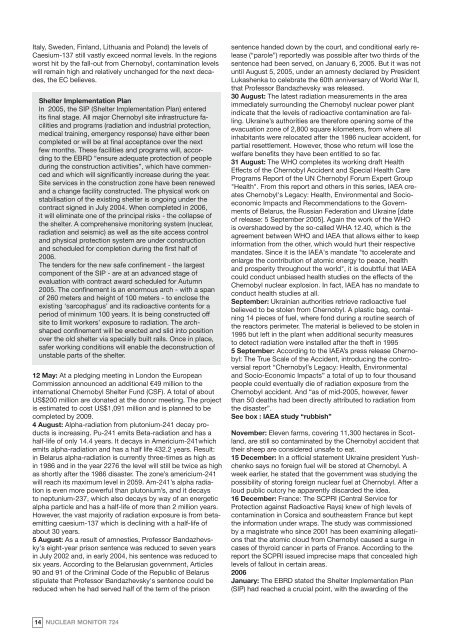
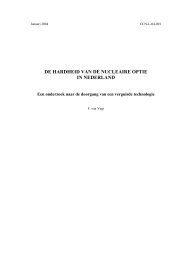


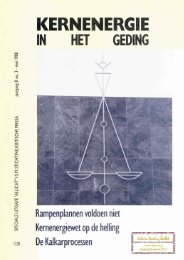
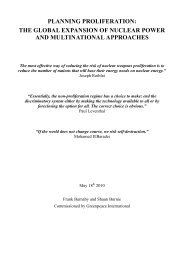
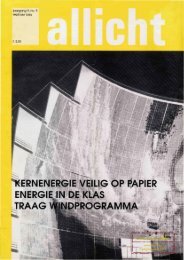

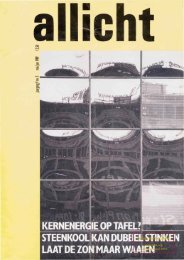
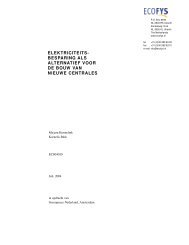

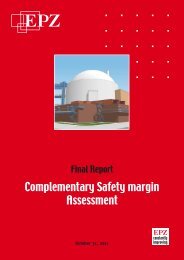

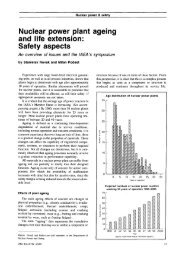
![EPZ jaarverslag 2009 [PDF] - Laka.org](https://img.yumpu.com/40394048/1/190x190/epz-jaarverslag-2009-pdf-lakaorg.jpg?quality=85)
